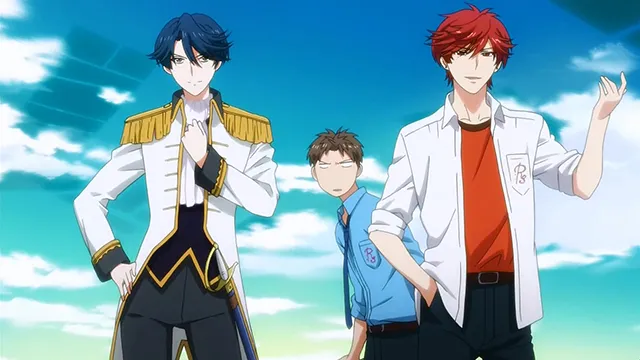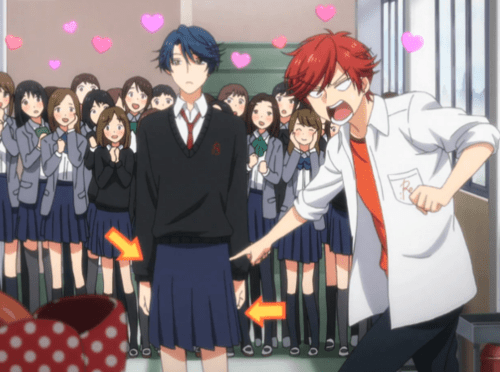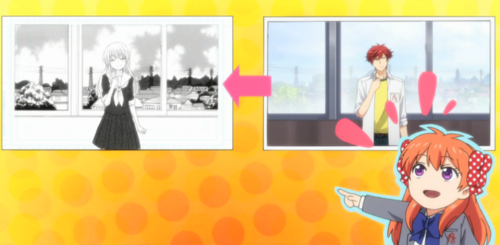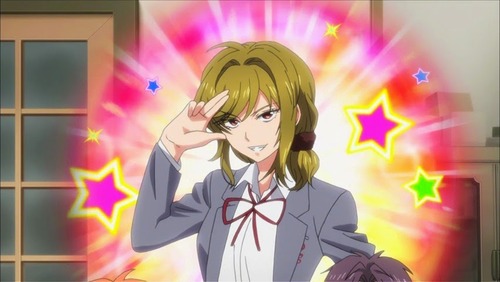The following was originally posted on Dee Hogan’s blog Josei Next Door and has been republished with permission.
For those who haven’t seen Gekkan Shoujo Nozaki-kun (“Monthly Girls’ Nozaki-kun”) yet, it’s a comedy about a high school girl who finds out her crush is secretly a popular shoujo mangaka (comic artist). She ends up working for him as one of his assistants, and the story follows the two of them and their friends/assistants as they navigate life at school and at work.
Simultaneously very funny and sneakily brilliant, it’s one of those rare beasts that can provide smart satire without coming across as pretentious or bitter. While it does play with anime/manga tropes quite a lot, I feel like there’s a universality to the humor and ideas that can work even if you’re only a casual anime viewer. In short: You should be watching this series.
Now Nozaki-kun is more like a sitcom than a serial, so there’s not much in the way of plot points I can “spoil” here. That said, I will be discussing the premise, the characters, and a few key scenes from the first four episodes of the show, so if you’re a purist who doesn’t want to know any specifics going into a series, then you’re going to want to back away along with Sakura down there, hop on over to Crunchyroll or Hulu, watch the first four episodes, and rejoin us when you’re finished. I’ll see you in a couple hours.
The rest of you should scroll past our annoyed heroine and have some fun with metafiction. Anicrit, ho!
THE THREE REVERSALS OF NOZAKI-KUN
“Reversal of expectations” is one of those phrases you start hearing the moment you walk into any kind of course about creating or studying works of fiction. Simply put, it means anticipating what your audience thinks will happen or should happen, and then doing the opposite. It’s one of the most effective ways to create surprise, rage, or humor, and it’s an especially useful tool if you want your audience to question their own preconceived notions.
Pretty much every comedy uses this tool to some extent, but through its use of characters and metafiction, Nozaki-kun manages the rare feat of a triple-reversal, and all three deal with our understanding of gender roles in fiction.
Monthly Girls’ For a Boys’ Monthly – The Audience
The first reversal isn’t one a worldwide audience would notice unless they pay attention to Japanese manga labels, but Nozaki-kun runs in the web magazine Gangan Online, which is technically marketed towards the shounen (boys) demographic. In other words, Nozaki-kun is officially a shounen series.
When we think “shounen,” we generally think male protagonists going on adventures and fighting bad guys (a la Naruto or the Dragonball series), and I think it’s safe to say that Nozaki-kun is about as far from that as you can get. Not only does it feature a female protagonist (almost unheard of in the genre), but it’s actually about shoujo (girls) manga, and has all the trappings of a shoujo high school rom-com (complete with flowers and sparkles) to boot.
To top it off, the series is penned by Tsubaki Izumi (The Magic Touch, Oresama Teacher), a mangaka whose previous works all ran in the shoujo magazine Hana to Yume (“Flowers and Dreams”). Put it all together and Nozaki-kun is like a chef writing “chicken” on the menu and then bringing out an eggplant: Its mere existence is something of a surprise (and a damn sneaky way to get someone to try eggplant, too).
“Say Hello to the New Heroine” – The Characters
Nozaki-kun’s refusal to conform to its own genre sets the stage for its cast, most of whom defy gender norms in one way or another. In the interest of keeping this to a manageable length I’ll only touch briefly on the characters featured in the first four episodes of the series.
First we have the titular character, Nozaki Umetarou, the male high school student who writes the popular shoujo manga series Let’s Fall in Love. He writes under a female pen name, but both his character design (tall, broad-shouldered, sharp features) and personality (cool-headed, laconic, a bit oblivious) are so traditionally masculine that no one suspects him of his double life.
Nozaki is joined by a group of supporting characters who, in classic comedy fashion, are all eccentrics in one way or another. Shy Mikorin puts on a cool front but is secretly awkward and easily embarrassed around the opposite sex; Seo is loud-mouthed, cheerfully aggressive, and tactless; Kashima is a “prince” (think Tamaki from Ouran High) in the drama club who flirts with every girl in school; and Hori is the responsible director who must keep the prince in check.
And man, it was really hard to avoid pronouns in that last sentence, but I managed it, because I wanted to highlight how the actual sex of each of those characters is the opposite of what we’d normally expect in a shoujo (or really, any genre) series. Yes, awkward Mikorin is male, loudmouth Seo is female, as is our princely Kashima, and her beleaguered director is a boy.
Japanese is a largely pronoun-free language, so before we meet each character in the series we’re treated to a genderless description of them. The rest of the characters on the show then use this description to create a mental image of the character (the “refreshing” girl Mikorin, the suave boy prince)—an image which is, of course, immediately shattered once they actually meet the person in question.
(It’s worth noting that while the series acknowledges that its characters don’t behave the way their sex is expected to behave, it does not punish them for being that way. For example, everyone gives Kashima grief for being an irresponsible flirt, but that’s because Kashima is an irresponsible flirt—it has nothing to do with the fact that Kashima is a girl who identifies as a prince.)
Perhaps the only character in the cast who doesn’t explicitly subvert gender expectations is the protagonist, Sakura Chiyo. She’s not exactly a stereotype but she does fit the role of the “shoujo heroine” fairly well, as her defining characteristics are her interest in art and her massive crush on Nozaki. Instead, most of Sakura’s humor comes from the fact that she wants to be in a shoujo romance and keeps realizing that she’s not. As such, she often acts as the POV character for the audience, reacting with surprise and sweatdrops to the antics of the cast around her as they continue to subvert her idea about how this world should behave.
“This Love Is Being Turned into a Shoujo Manga” – The Fiction
Of course, neither Sakura nor the audience would have these expectations about genre and gender if they hadn’t lived in a culture where these ideas were so prevalent. Sakura and her friends have zero real-life experience with actual romance or even with a lot of different kinds of people; instead (and like so many of us), they rely on the stories and characters they encounter in fiction to give them an idea of what the world is “really” like. And when the real world inevitably proves to be very different from the world of fiction, none of them knows what to do about it.
Nowhere is this better portrayed than in the magnificent Episode 4 (“There Are Times When Men Must Fight”). In the first half of the episode, we learn that Mikorin “learned how to talk to girls” by playing dating sim video games, where he acts as the male protagonist trying to hook up with one of several female stereotypes (“the tomboy,” “the refined heiress,” etc.).
When Nozaki attempts to play the game, he fails miserably, because he keeps making choices based on how a shoujo manga hero would behave. “You’re playing from the girl’s perspective,” Mikorin scolds him. “You have to play from the guy’s perspective.” Mikorin calls up Sakura to help prove his point, but when Nozaki talks to her the same way he tried to talk in-game, it only deepens her feelings for him. After all, Sakura also reads shoujo manga, so she believes this is the way the romantic interest “ought to” act, too.
This scene shows how differently “boys’ fiction” and “girls’ fiction” depict gender relations, and how that depiction affects the expectations and behavior of the person who reads/watches that fiction (regardless of that person’s own sex or gender). It also ultimately highlights the superficial nature of the relationships developed in dating sims, as Nozaki and Mikorin realize that the protagonist’s real soul mate is none of these fickle girls but his best (male) friend, Tomoda (a gag which has so many layers you could probably write an entire paper on it alone, but in the interest of keeping this under novel length, I’ll just leave it at that).
All of which brings us to the show’s final reversal, and the one that I think elevates it above good comedy and into the realm of metafictional genius: Nozaki-kun’s own writing. In both Let’s Fall in Love and the plays he writes for Hori, Nozaki takes the real people around him and transforms them into characters. But instead of writing them as they are, he takes his friends’ personalities and maps them to the “expected” sex/gender. So Mikorin becomes the manga’s heroine, Seo becomes the boorish male rival, and Kashima is cast as a male prince. Despite knowing full well that his fictitious “reality” is nothing like the actual reality, Nozaki conforms his writing to both genre and gender expectations, maintaining the status quo.
Even more surprising, he keeps buying into his own myth, as time and again he uses shoujo manga as the basis for his understanding of real-world situations. This is best represented in the second half of that wonderful Episode 4, where Nozaki, Mikorin, and Sakura are practicing how to behave at a mixer, and all of Nozaki’s expectations are textbook shoujo tropes. “Basically, with mixers, you take people by force, get taken by force, or kidnap someone, and you’re set,” he explains, proving that all his “knowledge” comes from works that not only bear no resemblance to reality, but depict a reality where no one should want to live.
A BREAK WITH TRADITION AND A RETURN TO FORM: NOZAKI-KUN AND THE SHOUJO GENRE
In its trio of reversals, Nozaki-kun first takes its audience’s expectations and disassembles them, then takes its characters’ expectations and disassembles them, and then takes all those disassembled pieces and reassembles them back into their expected forms. What we end up with is a kind of perpetual motion machine, an endless cycle where fiction (shoujo manga) shapes expectations (the characters’ beliefs) which then shape future fiction (Nozaki’s manga), and on and on, leaving the nuances of reality (the characters themselves) stuck in the middle, left out and ignored.
However, by spending so much time with its expectations-defying characters—i.e., in “reality”—Nozaki-kun itself manages to break free from this cycle. Sex and gender are not as uniform and conventional as much of our fiction would have us believe, the series cheerfully tells us, and here are a bunch of awesome characters to prove it. Like all great satire, Nozaki-kun isn’t just showing us a busted system: It’s providing us with an alternative and encouraging us to follow in its footsteps.
I’ve seen a lot of people referring to Nozaki-kun as a “parody of the shoujo genre,” but I don’t think that’s quite right. Shoujo is a historically progressive genre, particularly when it comes to challenging traditional assumptions about gender and sexuality. From Tezuka’s Princess Knight (considered the first shoujo series) to Ikeda’s Rose of Versailles to the more modern classics like Sailor Moon, Revolutionary Girl Utena, or Cardcaptor Sakura, the great shoujo series are famous for their well-developed female protagonists and inclusion of LGBT characters.
So to say Nozaki-kun is a parody of the shoujo genre is to ignore the foundations of the shoujo genre itself. Rather, it’s more accurate to say the series is a satire of the current anime/manga industry, which seems to have a much more conservative mainstream than it did 20 or even 10 years ago. Nozaki-kun shows how the current market ignores both reality and past fiction (there were plenty of female princes in the shoujo of old, after all) in favor of increasingly narrow ideas about who boys and girls are “supposed” to be. And these narrow ideas don’t just misrepresent reality—they can also shape it, changing the way their audiences view both themselves and the world around them.
If anything, Nozaki-kun isn’t shaking off the shoujo genre but rather returning it to its roots, using humor and metafiction to challenge the same traditional gender roles that the classic shoujo titles of the past once did. Is it perfect? No—none of those past shows were, either—but it’s a damn fine effort, and a welcome voice of subversion in an increasingly uniform chorus. Write on, Nozaki-kun. I’ll be laughing and nodding along with you every step of the way.
Dee (@JoseiNextDoor) is a writer, a translator, a book worm, and a basketball fan. She has bachelor’s degrees in English and East Asian studies and a master’s degree in Creative Writing. To pay the bills, she works as a technical writer. To not pay the bills, she writes young adult novels, watches far too much anime, and cheers very loudly for the Kansas Jayhawks. You can find her at The Josei Next Door, a friendly neighborhood anime blog for long-time fans and newbies alike.
Are you following The Mary Sue on Twitter, Facebook, Tumblr, Pinterest, & Google +?













